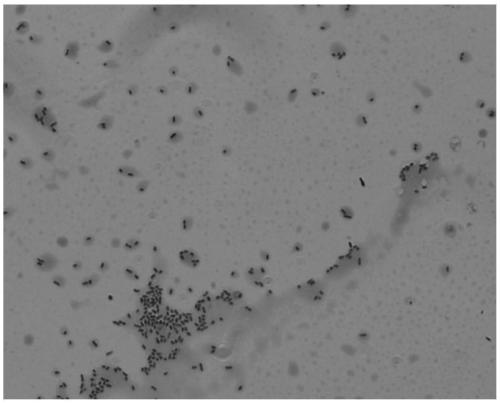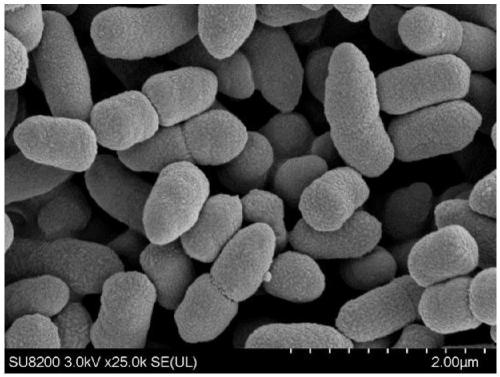Trehalase production strain and application thereof
A technology of trehalase and trehalose, applied in the direction of glycosylase, enzymes, bacteria, etc., can solve the problems of trehalase enzymatic characteristics, such as low energy consumption, high activity and stability, and increase ethanol yield effect
- Summary
- Abstract
- Description
- Claims
- Application Information
AI Technical Summary
Problems solved by technology
Method used
Image
Examples
Embodiment 1
[0035] Example 1: Enrichment and screening process of Erwinia rhapontici
[0036] Collect the soil samples domesticated by trehalose near Wuxi Changguangxi Wetland Park and Jiangnan University. When collecting the soil samples, first use a small shovel to remove the topsoil, use a disinfected plastic bag, and collect the soil from 5-10cm. Take a sample of about 50g, seal it, and record the time, place, and environment. Take 5g of fresh soil sample and dissolve it in 45g of sterile water, take the supernatant and put it into the Erlenmeyer flask containing the enriched medium, shake the flask for 24h. Take 1 mL of the enriched and cultured bacterial solution and transfer it to a pre-prepared test tube containing 9 mL of sterile normal saline, and shake it on a vortex shaker to make 10 -1 The concentration of the sample suspension; then draw 1mL from the above suspension, add it to a test tube containing 9mL of sterile normal saline, shake well to make 10 -2 The concentration of th...
Embodiment 2
[0040] Example 2: Identification of morphological and physiological characteristics of Erwinia rhapontici
[0041] The strains were streaked on a solid LB medium plate, and the colonies that grew out were round, raised, and off-white. The center and surrounding parts of the colonies had no other colors and were easy to pick. Gram staining is red. Observed under an optical microscope, the cells are mostly straight rods with a length of 0.5-1.0μm×1.0-3.0μm. They are solitary or in pairs, sometimes short chains. The strain is gram-negative, oxidase-negative, contact enzyme-positive, and produces acid from fructose, galactose, D-glucose, β-methyl glucoside and sucrose. Malonate, fumarate, gluconate, and malate can be used as the only carbon source and energy source, but benzoate, oxalate, or propionate cannot be used. Identification under microscope and electron microscope ( Figure 1-Figure 3 ).
Embodiment 3
[0042] Example 3: Molecular biological identification of Erwinia rhapontici
[0043] Collect the bacteria grown in the liquid fermentation medium, select the 16S rDNA universal primer 27F (AGAGTTTGATCCTGGCTCAG), 1492R (GGTTACCTTGTTACGACTT) to PCR amplify the bacterial genome, and configure a 50μL PCR reaction system in a 200μL PCR tube according to the formula in Table 2. . After mixing the solution, centrifuge slightly to make the solution completely at the bottom of the PCR tube, and put the PCR tube into the PCR machine.
[0044] Table 2 PCR reaction system
[0045]
[0046] PCR amplification conditions: pre-denaturation at 94°C for 10min, denaturation at 95°C for 60s, annealing at 58°C for 60s, extension at 72°C for 90s, repeated 30 times, and final extension at 72°C for 10min. After the amplification is completed, the PCR amplification result is detected by gel electrophoresis. Stain with 1×TBE buffer, 10×Loading buffer, use 5000DL DNA Maker as the standard Maker, and run at ...
PUM
 Login to View More
Login to View More Abstract
Description
Claims
Application Information
 Login to View More
Login to View More - R&D
- Intellectual Property
- Life Sciences
- Materials
- Tech Scout
- Unparalleled Data Quality
- Higher Quality Content
- 60% Fewer Hallucinations
Browse by: Latest US Patents, China's latest patents, Technical Efficacy Thesaurus, Application Domain, Technology Topic, Popular Technical Reports.
© 2025 PatSnap. All rights reserved.Legal|Privacy policy|Modern Slavery Act Transparency Statement|Sitemap|About US| Contact US: help@patsnap.com



